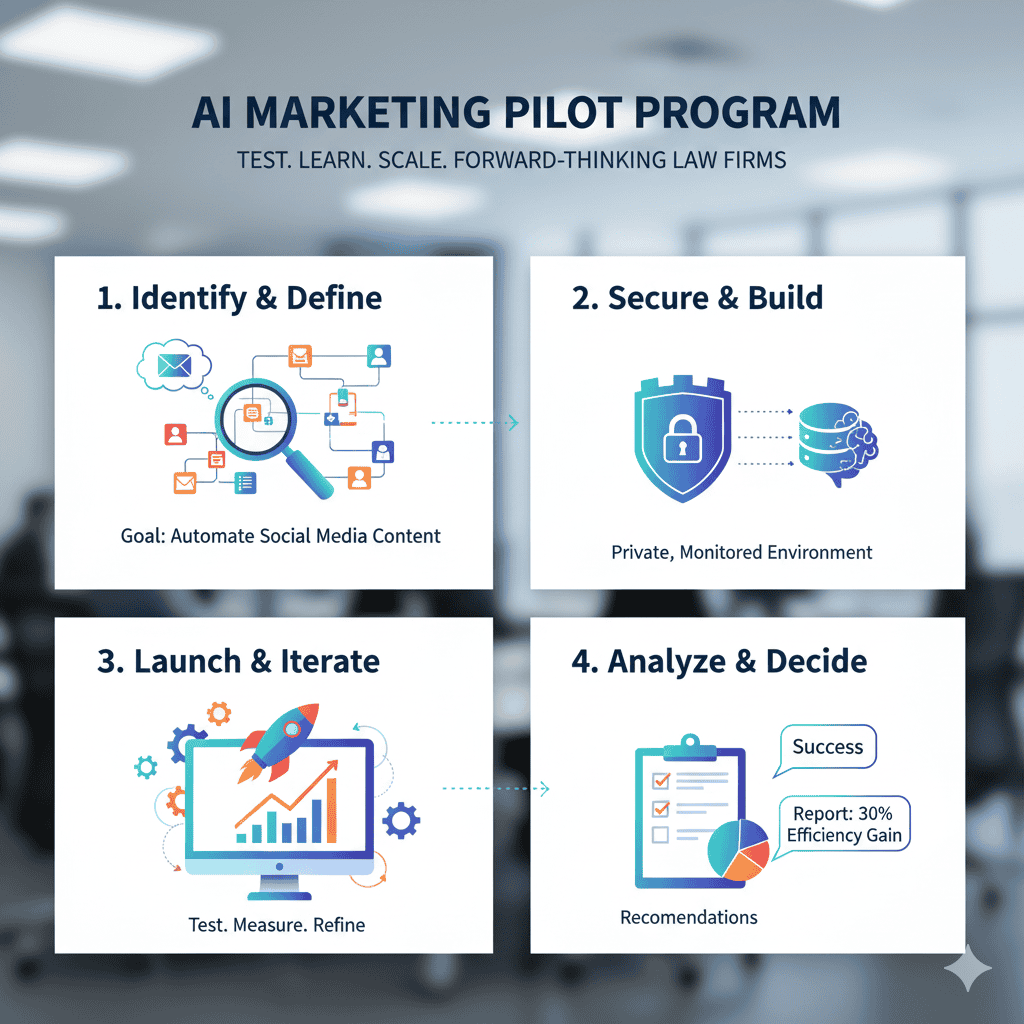I get it. Integrating AI into your marketing technology stack can feel like a game of whack-a-mole with how quickly the tech is changing. And your marketing team has its hands full already dealing with the daily blocking and tackling.
The thing is, it’s here whether your team is ready or not. So get started.
As the old joke goes, the only way to eat an elephant is one bite at a time.
Bite 1: Establish a Shared Baseline of Understanding
Survey the team about their use of and comfort with AI, and you’ll get lots of questions.
- “I only know how to use AI to help me write email. I have no idea how else to use it.”
- “Does the firm even allow us to use AI?”
- “How do I make sure I am not sharing client data?”
- “Marketing is a creative business – can AI really produce something that is on brand?”
- “AI hallucinates and therefore isn’t trustworthy.”
Address this confusion by requiring foundational training (such as the AI Academy for Marketers offered by SmarterX) and holding regular departmental AI discussions so everyone understands the state of AI in marketing generally, the firm’s stance on the use of AI to perform their work, and the tools available to them. Share use cases, lessons learned, and success stories.
Making Your First Bite Tasty
- Highlight success stories and let your innovators shine.
- Promote training resources. Include money in the budget for research, professional development, and piloting proofs of concept.
- Allow for failure. This is new territory for everyone, so this needs to be a safe space to learn and improve over time.
- Make sure everyone knows what’s available and what’s expected of them.
- Develop and promote a roadmap so your entire team knows what true north looks like and the timeline you plan to accomplish your AI goals within.
- Position AI training as career security – not just within your firm, but beyond. People will appreciate knowing they are keeping their skills honed. AI training is a gift and shows your commitment to their success.
Bite 2: Audit Your Environment and Identify Use Cases
Martech Audit
Everyone is talking about leveraging AI in marketing. But plugging a powerful AI tool into a chaotic tech stack is a recipe for wasted investment and disappointing results. To truly boost efficiency, creativity, and productivity, your technology foundation must be strategically prepared.
Begin by taking stock of your currently available tech, your team member roles, and the outcomes you deliver daily, weekly, and long term.
- Pinpoint repetitive manual effort: Identify the time-consuming, repeatable tasks that are prime for automation, freeing up your team for more creative and strategic work.
- Identify high-impact AI opportunities: Document every use case—from content creation to lead nurturing—where AI will deliver the greatest return on efficiency and performance.
- Unify your data: AI is only as good as its data. Map out a plan to break down silos and create the clean, connected data source your new tools need to thrive.
- Optimize your stack for integration: Identify which legacy tools can be consolidated or replaced, ensuring new AI platforms integrate seamlessly without creating more complexity.
- Build a strategic AI roadmap: Move from scattered experiments to a deliberate plan. Identify a scalable use case for AI integration and a phased approach for implementation that aligns with your growth goals.
Bite 3: Pilot a High Value Use Case
Your First Pilot
Instead of a firm-wide overhaul, a targeted pilot program allows you to test, measure, and prove the value of AI on a specific marketing challenge. Design a controlled, low-risk pilot that delivers clear results. A pilot allows your team to experience the benefits of AI firsthand and allows you to refine the workflow and data before rolling it out to a wider set of users. Possible early pilot focus areas:
- Enhancing team productivity: Automate the summarization of meeting notes, webinar transcripts, and research to give your team more time for strategy.
- Accelerating content creation: Rapidly draft reports, practice area descriptions, and internal communications that align with your firm’s brand voice.
- Automating business development intelligence: research hundreds of contacts before a client event. The AI can generate one-page client briefs about each guest, equipping your attorneys with their latest company news, professional milestones, and personalized talking points to ensure every conversation is meaningful and informed.
Learn. Refine. Rinse. Repeat.
The speed of your progress will vary depending on the complexity of the use case, the number of stakeholders, and the technology implementation timeline. I recommend starting small so that you can build the muscle and the confidence in your team.


